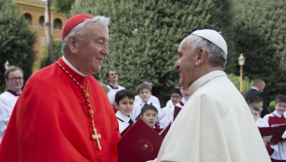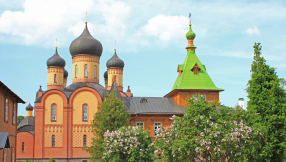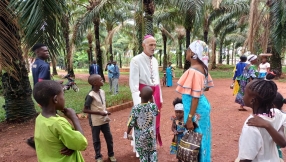
The writer of the Letter to the Hebrews reminds Christians that they are surrounded by a great "cloud of witnesses." (NRSV) That "cloud" has continued to grow in size since then. In this monthly column we will be thinking about some of the people and events, over the past 2000 years, that have helped make up this "cloud." People and events that have helped build the community of the Christian church as it exists today.
In the 20th century a great deal of discussion – and controversy and disagreement – was generated by contrasting viewpoints concerning the way the Holy Spirit is experienced by individuals and communities and the impact of this on services and worship. That dynamic conversation and exploration continues. It has its roots in the experiences of the Early Church.
The New Testament and the work of the Holy Spirit
It is not possible to do justice here to the way in which the New Testament speaks of the power of the Holy Spirit. But, as an overview, the early followers of Jesus soon began to say that, although he was no longer among them physically, he was still present in their lives and in their actions. The unseen – but personally experienced – power of Jesus was living in their lives and in their communities. This experience of the power of Jesus was made possible, they claimed, because God had poured out his Holy Spirit on the individual members of the Christian community. This had started at Pentecost, as recorded in the Book of Acts, chapter 2 (although a preliminary giving of the Spirit is stated in the Gospel according to John, as recorded in John 20:22, before Jesus' ascension), but was ongoing whenever a person came to faith in Christ.
This was not an impersonal force, nor were Christians dependent only on the principles and guidelines that had been left by Jesus. Instead, they claimed that Jesus the Christ was alive and living in them. In short, the invisible power of God – that they had intimately experienced in their relationship with Jesus – was now even more intimately living in them and uniting them with God. This empowerment was the work of the Holy Spirit.
The situation after the close of the 'Apostolic Age'
Later Christians would fall out over arguments over whether the Holy Spirit proceeds from the Father and the Son, or solely from the Father, and this would become a major source of division between Eastern and Western Christian communities.
As contentious were different attitudes towards whether – or how – activities attributed to the work of the Spirit (for example speaking in tongues, prophecy, words of knowledge, healing, etc) continued to be experienced in the life of the Christian community. Were they still the evidence of spiritual renewal in individuals or was this now channelled through the institutions of the Church? And had the most dramatic of these ceased to occur with the close of the Apostolic Age (an outlook described as 'cessationism')?
The course of these debates and disagreements is complex but an official view emerged which assumed the ending of the most dramatic of these 'gifts,' and a channelling of the others through authorised Church authorities. Against this view, movements (some orthodox in theology, some heretical), proclaiming renewal of the Church, continued to exhibit 'gifts of the Spirit' at a number of points in Church history; even if this was condemned by Church hierarchies. The latter usually classifying such behaviour as personal enthusiasm or outright heresy.
This was the complex and conflicted historic background to events which occurred in the early 20th century and which have had a significant ongoing impact on the Christian community.
'Charismatic' Christian movements in the 20th century
Christianity is a 'Holy Spirit faith.' By which it is meant that, from the earliest days, Christians have believed that they have a living experience of God in their lives and communities because of the presence of the Holy Spirit. However, some groups have placed particular emphasis on the experience of the Holy Spirit, and this has had a major impact, of historic proportions, on the global Church in the 20th and 21st centuries.
So-called 'charismatic Christianity,' also sometimes termed 'Spirit-filled Christianity' and 'Renewed Christianity,' places strong emphasis on the work of the Holy Spirit in the life of a believer, on the continued existence and use of spiritual gifts and on miracles and 'signs and wonders.' The word 'charismatic' comes from the Greek word charismata, meaning 'grace (spiritual) gifts.' It is this emphasis – and expressions of it, such as speaking in tongues and prophecy – that has become a defining feature of this movement (really movements, plural), which is not contained within one denomination or pattern of church.
Some Christian denominations, such as Pentecostals, have a theology and practice which has a major focus on spiritual gifts as part of a personal experience of Christ and revealed in services. Growing out of a movement called the 'Holiness Movement,' Pentecostal churches took on a distinct character from the early twentieth century. The stimulus to this included the 'Azusa Street Revival' (in Los Angeles), which started in 1906 and lasted for three years (some commentators extending it to 1915). This was at a time when many mainstream churches taught that the spiritual gifts seen in the Acts of the Apostles, and referred to in the letters of Paul, were no longer to be found in the Church. Pentecostals, in contrast, explicitly proclaimed that this was not the case and that Christians still experience these in their daily lives.
Associated with what is often termed 'Baptism in the Holy Spirit' or 'Filling with the Holy Spirit,' this experience may be linked to initial conversion or as a second phase of 'deepening' after conversion. It may, or may not, be associated with the laying on of hands. Some within the broad movement differentiate 'Baptism in the Holy Spirit' from 'Filling with the Holy Spirit,' with 'baptism' being used to describe the initial encounter with the Holy Spirit and 'filling' being used for subsequent experiences of additional renewal. There is no hard and fast rule as to how these terms are used and different Christian individuals and groups may use them differently.
While Christians differ – sometimes stridently – in their response to these beliefs (from Azusa Street to the present day) it is undeniable that the movements that have flowed from it have been a major force in the development of the modern global Church.
From Pentecostalism outwards ...
From the 1960s, these ideas began to spread through several of the mainstream denominations, both Protestant and Catholic. As a result, one can now find both individuals and churches whose beliefs and practices would be described as 'charismatic,' while still being part of a wider church network (eg the Church of England, the Roman Catholic Church, the Baptist Church, etc) which is not officially of this persuasion overall. This widespread phenomenon has often been referred to as the 'Charismatic Movement.' While sharing many characteristics with Pentecostals, there may be less emphasis on speaking in tongues as a defining sign of 'Spirit Baptism' (something frequently emphasised in Pentecostalism), but this varies.
While this phenomenon has affected all Protestant denominations and the Roman Catholic Church, there seems rather less evidence of it within Eastern Orthodoxy. However, this last point needs qualifying. In North America there is some evidence of conversion to Orthodoxy involving a small but noticeable number of Christians coming out of a charismatic background. They appear to want the personal and emotional 'experience' of Christ but also the historical roots and validity that they see in a church rooted in the rulings of the early ecumenical councils. In this way, very different traditions – which both offer experiential forms of Christianity – may at times combine.
Another group of churches are sometimes referred to as 'Neo-charismatic' churches or 'Third Wave,' referring to three great moves of the Holy Spirit: the first in the early twentieth century leading to Pentecostalism, the second in the 1960s leading to the Charismatic Movement and the third from the 1980s and 1990s onwards.
While there is no such thing as a definitive charismatic church gathering, due to the large number of traditions represented, there are nevertheless certain characteristics that occur across a number of these church communities. These include a high degree of informality; extended times of worship, often using contemporary musical styles and worship bands; Bible-based preaching, although in some churches the teaching may be based rather more on personal spiritual experience than on detailed scriptural exposition; congregational participation through speaking in tongues, shared words of knowledge, prophecies, visions and 'pictures' (shared images which illustrate a spiritual message).
There can also be a fairly high profile for women since charismatic inspiration (for example in prophecy or words of knowledge) is often not bound by entrenched social and gender norms or expectations. This can circumvent male-orientated authority and teaching structures by giving increased opportunity for the female voice within churches.
The movement is global and can be experienced in US and European churches of many types, South Korean mega-churches, Chinese house-churches (often meeting without official government agreement), in independent African churches, and in South America (very noticeably in Brazil for example). Not surprisingly, there is no uniformity of experience, but common features can often be discerned.
Many of these communities enjoy good relations with each other, and members – much less conscious of 'denomination' than in previous periods of history – may move from one to another with relative ease due to common experiences (even when aspects of doctrine may vary). It has been estimated that 'charismatic Christians' number somewhere in the region of 500 million people, or 25% of the Christian population of the world, and this is increasing. The movement is widely regarded as the fastest growing area of contemporary Christianity and, consequently, it has reshaped the demography of the Church; and continues to do so. This is because there has been an explosion of 'charismatic churches' in the southern hemisphere and in churches within the global African diaspora.
Is there such a thing as a distinctive 'charismatic Christology'?
Charismatic Christian communities tend to be theologically conservative, Bible-based and very much within the traditional creedal mainstream of Christianity. As a result, the emphasis on the deity of Christ, the reality of the Incarnation, the harm caused by sin and the need for repentance, atonement through the cross and the bodily resurrection of Christ all underscore the traditional theological and creedal nature of this broad movement. There may be an emphasis on eschatology and the Second Coming of Christ but, again, this is a current that has always flowed within the Christian mainstream.
On reflection, though, it could be fair to suggest that communities arising from these movements have contributed to a rethinking of the relationship of the believer with Christ and expectations of Christ. A relationship is often asserted to be a key feature of charismatic Christology: the idea that the believer can experience a personal connection with Christ, a sense of unity with him and an immediacy of divine Christ-presence through the experiential aspects of charismatic worship and the exercise of spiritual gifts. The other issue is expectation. With an emphasis on inspired messages, healing, and deliverance from spiritual bondage, this can be presented as a Christology of an active and liberating Christ.
While Christians in the 21st century continue to debate – and at times disagree – concerning these issues, it is clear that these interconnected movements have had a significant impact on the global Church. And this is ongoing.
Martyn Whittock is a historian and a Licensed Lay Minister in the Church of England. The author, or co-author, of fifty-six books, his work covers a wide range of historical and theological themes. In addition, as a commentator and columnist, he has written for several print and online news platforms and is frequently interviewed on TV and radio news and discussion programmes exploring the interaction of faith and politics. His recent books include: Trump and the Puritans (2020), Daughters of Eve (2021), Jesus The Unauthorized Biography (2021), The End Times, Again? (2021), The Story of the Cross (2021), Apocalyptic Politics (2022), and American Vikings: How the Norse Sailed into the Lands and Imaginations of America (2023). He is currently writing Vikings in the East: From Vladimir the Great to Vladimir Putin, the Origin of a Contested Legacy in Russia and Ukraine (2025 forthcoming). He explored something of the impact of the theology of the Holy Spirit in modern church communities in the co-written Christ: The First 2000 Years (2016).













